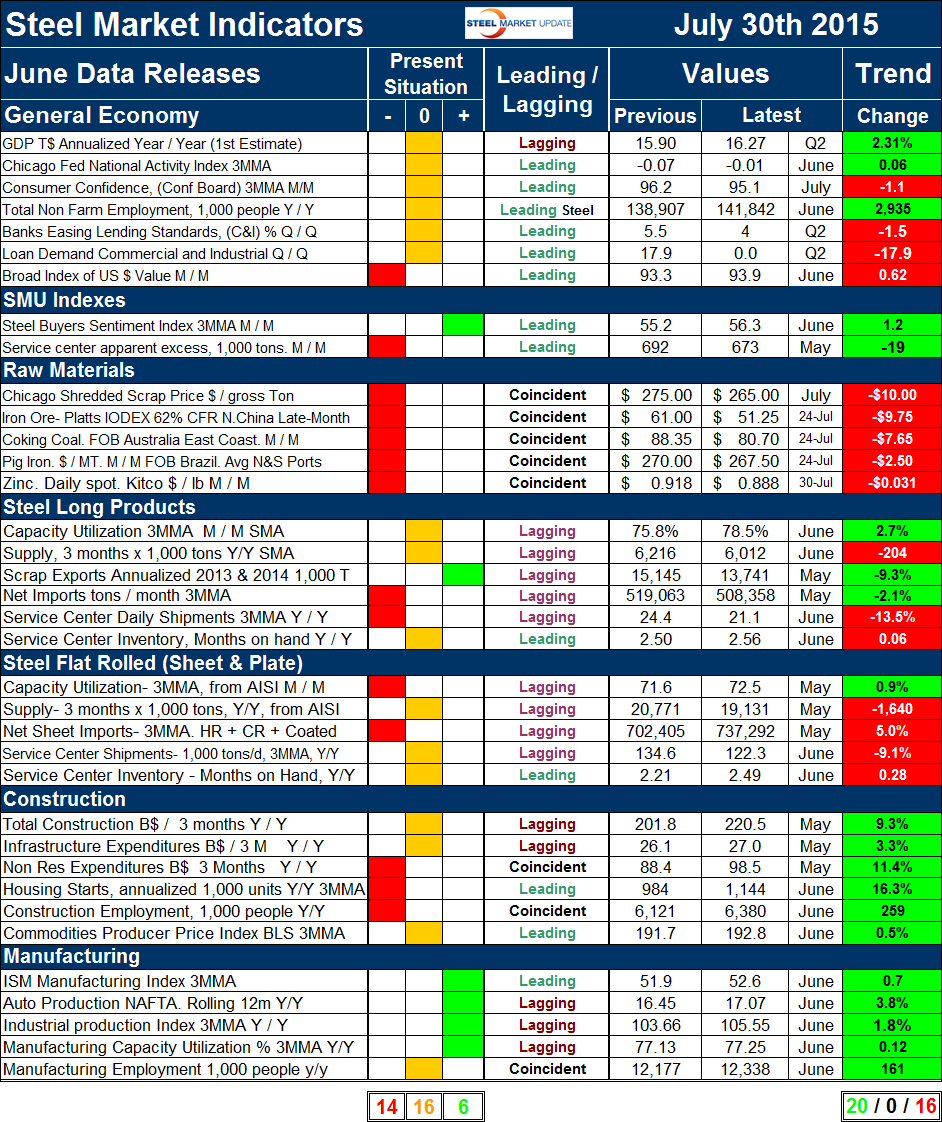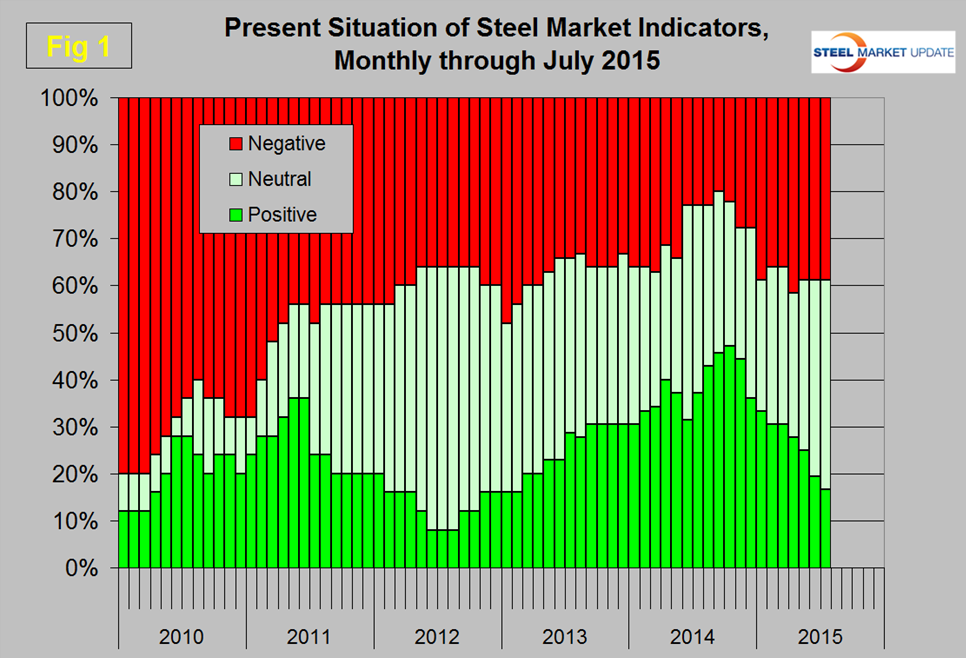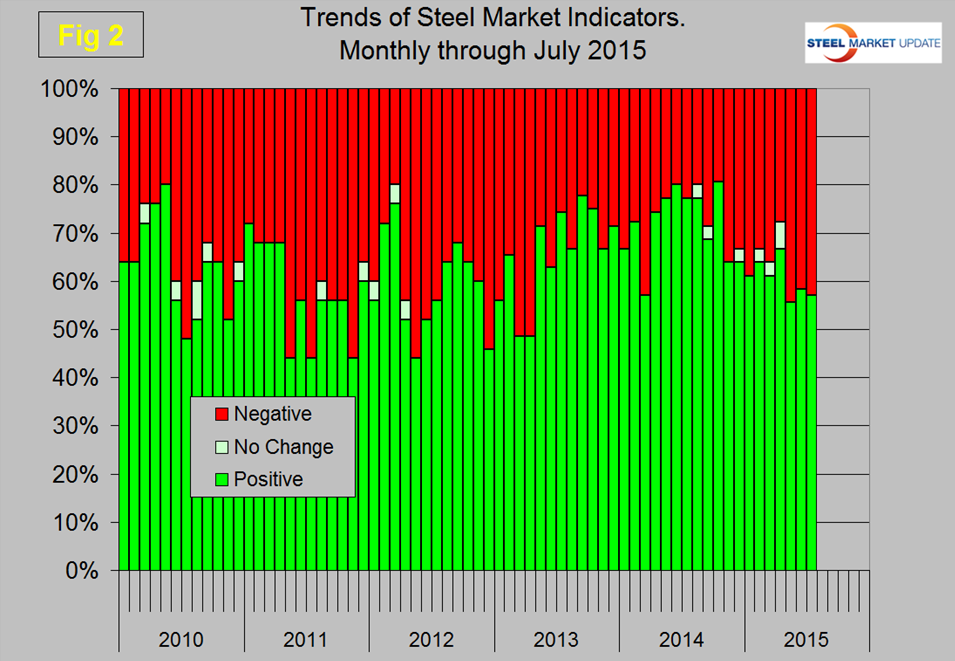Market Data

July 31, 2015
Key Market Indicators - July 30, 2015
Written by Peter Wright
An explanation of the Key Indicators concept is given at the end of this piece for those readers who are unfamiliar with it.
The total number of indicators considered in this analysis is currently 36.
![]()
Please refer to Table 1 for the view of the present situation and the quantitative measure of trends. Readers should regard the color codes in the present situation column as a quick look at the current market condition. This is a subjective analysis based on our opinion of the level of each indicator. The “Trend” columns of Table 1, are also by their color codes designed to give a quick visual appreciation of the direction in which the market is headed. However the quantitative analysis of the value and direction of each indicator over time are the latest “facts” available. There is nothing subjective about the trends section which is designed for those readers who want to dig deeper. All data included in this table was released in July, the month or specific date to which the data refers is shown in the second column from the far right and all data is the latest available as of July 30th.
Present Situation: There was a decrease of one in the positive and an increase of one in the neutral column in the last month which currently summarizes to 14 negative, 15 neutral and 7 positive. We now have 5.5 years of this analysis and have graphed the changes in the present situation and trends over time. Figure 1 shows the change in our assessment of the present situation since January 2010.
The number of indicators classified as positive peaked at 17 in October last year and now stands at 7 with a steadily declining trend. Changes that occurred in the month of July were as follows; GDP was re-classified from positive to neutral on the basis of this week’s first estimate for growth in Q2 2015. We base our evaluation on a trailing 12 month result which is currently less than our positive threshold of 2.5 percent. The price of zinc at the end of July fell below 90 cents per lb. and we re-classified it from neutral to negative. Capacity utilization of the long product mills was re-classified from negative to neutral with a value of 78.5 percent. The performance of the long product mills is based on SMA data and of the flat rolled mills on AISI data. There were no changes in our perception of the present situation of the indicators describing the flat rolled steel market, or the construction and manufacturing sectors. A quick visual appraisal of the present situation shows that the general economy is basically neutral. Steelmaking raw materials are historically weak through July’s data. The present situation of the flat rolled steel sector is very similar to that for long products. Construction continues to be weak to neutral and manufacturing continues to be neutral to strong. Both nonresidential and residential construction starts are rated historically negative as is the total number of people employed in construction. No indicators are currently rated positive in the construction category. None of the manufacturing indicators on a present situation basis are currently negative. Four are positive and one, manufacturing employment is neutral.
Trends: Twenty of thirty six indicators are trending positive on July 30th which was a decrease of one from the June 27th update. Sixteen are trending negative which was an increase of one. Figure 2 shows the trend of the trends.
The direction of trends was fairly steady in the six months through April but then declined in May and held that level for the last three months. The sky is not falling, currently almost 60 percent of the 36 indicators are trending positive. This analysis seems to fly in the face of the preponderantly negative news in the press but it is what it is and is in general agreement with the SMU steel buyers sentiment index.
Changes in the individual sectors are described below. (Please note in most cases this is not July data but data that was released in July for previous months.)
In the general economy there was one trend reversal. The trade weighted value of the US dollar which had been declining in May took off again in June which we regard as a negative for net steel imports. The trends of the two Steel Market Update proprietary indicators both continued to be positive, service center excess declined and steel buyer sentiment improved. All five of the steel raw materials prices that we track here declined in July. Last month Chicago shredded and coking coal had been trending positive. We expect scrap prices to take another hit when the data is released by AMM in the next couple of weeks. In the long products section, net imports of long products declined in May, (latest month available) after increasing in April. In the flat rolled steel section, capacity utilization reversed course and improved in May which is the latest data available from AISI. The long products numbers are based on data from the SMA who get their data out faster than the AISI. Net imports of flat rolled increased in May after declining in April. There was no change in construction trends, all indicators were moving in the right direction. The ISM manufacturing index reversed course in June and improved with the result that in this latest report all manufacturing indicators are moving positively.
The key indicators analysis somewhat bifurcated at present. Our view of the present situation has declined but at the same time more than half of the indicators are trending positive. SMU has several benchmark analyses that show steel demand has recovered more slowly than the general economy and is still not where it should be at this stage of a recovery.
We believe a continued examination of both the present situation and direction is a valuable tool for corporate business planning.
Explanation: The point of this analysis is to give both a quick visual appreciation of the market situation and a detailed description for those who want to dig deeper. It describes where we are now and the direction in which the market is headed and is designed to give a snapshot of the market on a specific date. The chart is stacked vertically to separate the primary indicators of the general economy, of proprietary Steel Market Update indices, of raw material prices, of both flat rolled and long product market indicators and finally of construction and manufacturing indicators. The indicators are classified as leading, coincident or lagging as shown in the third column.
Columns in the chart are designed to differentiate between where the market is today and the direction in which it is headed. It is quite possible for the present situation to be predominantly red and trends to be predominantly green and vice versa depending on the overall direction of the market. The present situation is sub-divided into, below the historical norm (-), (OK), and above the historical norm (+). The “Values” section of the chart is a quantitative definition of the market’s direction. In most cases values are three month moving averages to eliminate noise. In cases where seasonality is an issue, the evaluation of market direction is made on a year over year comparison to eliminate this effect. Where seasonality is not an issue concurrent periods are compared. The date of the latest data is identified in the third values column. Values will always be current as of the date of publication. Finally the far right column quantifies the trend as a percentage or numerical change with color code classification to indicate positive or negative direction.










